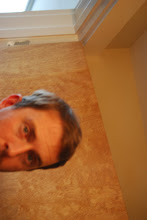I was visiting the Louvre in Paris with my friend Clint, the day after seeing Paul McCartney live in the Stade de Paris, and had written down the names of a few paintings that had really caught my eye right away. One was by a man called Antonio Campi... "Les Mystéres de la Passion du Christ"
It amazed me at the time, and still does. The scope of this painting is massive. There are things going on at every point in this image. The thing that intrigues me most though, is Campi's vision of what I'm assuming is Heaven (in the top right corner). The skies opening upon a giant reflective golden orb. It is all at once beautiful, breathtaking and ominous.
I was again reminded of this painting when I recently saw Knowing, a film that at first starts off with a great sci-fi premise and in the end finds itself lost in an amalgamized realm of Creationism and Scientology. I won't say the film was terrible, I will just say that it fuels the Creationist fodder a little bit. But here is not the place to discuss matters of Religion and Nicholas Cage.
The second painting was by a man called Hubert Robert titled, "Le Pont du Gard". This is the painting that brings back joyous memories of brand newness and love and language and walking and art and beauty. There is nothing spectacular in the way of religious spectacle as in Campi's work or much in the way of flashiness at all, but I think that's why I've fallen in love with it. Before a few days ago, I hadn't seen this painting in almost 5 years (saying it twice doesn't make it any less weird), and now having finally seen it again, I am transported back to that exact day, sitting on a bench across from the pyramid entrance to the Louvre. The lovliness of that day sticks with me forever. It was the day after first seeing a Beatle live, the first day of seeing art that truly struck a personal chord with me, and the second time I'd seen the Olympic torch run by. What a strange and wonderful day.
Here's Robert's "Le Pont du Gard" (1787)...




1 comment:
Cool paintings. I really wish I could see the detail on the first one. It's fascinating to see the 17th, 18th century artist's mental interpretation of ancient Biblical history and the spiritual realm, laid out visually.
Post a Comment